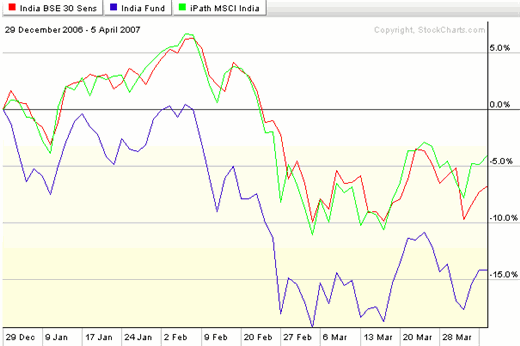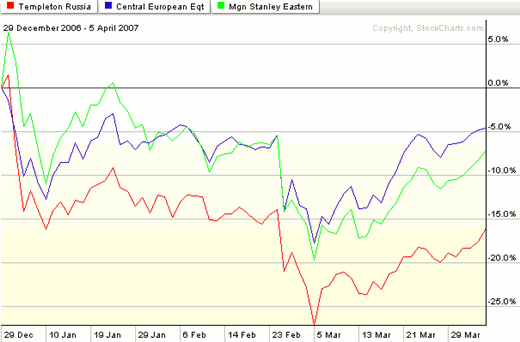Is it Time to Double Up on Brazil in your BRIC Portfolio?
Stock-Markets / Brazil Apr 11, 2007 - 12:20 PM GMTBy: Michael_K_Dawson
BRIC is becoming a fairly common acronym amongst investors. The term was coined in a research paper by Goldman Sachs in 2003 to describe an economic block composed of Brazil, Russia, India and China. The combination has the potential to be larger than the G6 in US dollar terms by 2050. Since the paper's release, investors have been scrambling for ways to leverage this theme. Last fall, Claymore introduced the first BRIC ETF (EBB).
Before the Claymore ETF, the easiest way to invest into the theme was to use country specific ETFs. In the past, I have used EWZ (Brazil), TRF (Russia), IFN (India) and FXI (China) to capture the trend. An advantage of the country ETF approach is the ability to specify your own weighting for each country versus being locked in to Claymore's weighting.
The results of this basket approach have been quite impressive. In 2006, an equal-weighted basket of EWZ, TRF, IFN and FWI returned 49% not including dividends. The basket was just as rewarding in 2005 with a 33% return. However, the wheels have fallen off this year. As of April 6, the basket is down -6.2%. What happened?
China has taken much of blame for the February 27 melt-down, so it must surely be the culprit. To no surprise, FXI is down -4.0%. However, the brunt of the basket's poor performance lies with TRF and IFN down -16.1% and -14.2% respectively. EWZ is the only one in positive territory up 9.4%.
IFN started underperforming the Bombay Stock Exchange towards the middle of last year and has continued in 2007. Improving the basket's performance may be as simple as replacing IFN with a better proxy for India. Barclays introduced IPath India MSCI Exchange Traded Note (INP) in December. An Exchange Traded Note is essentially a hybrid between a bond and an ETF. INP is tracking the Bombay Stock Exchange much better than IFN.

Continuing with this line of thinking; maybe there is a better Russian proxy available. Unfortunately, there is currently no way to get direct exposure to Russia through an ETF. TRF is comprised of Eastern Europe and Russia. The only other options are the Central Europe and Russia Fund (CEE) and the Morgan Stanley Eastern Europe Fund (RNE). An ETF specific to Russia is soon to be launched by Van Eck.

Modifying the basket to include IFN and CEE along with EWZ and FXI could possibly improve its performance going forward. However, what's more intriguing is adjusting the weighting of the ETFs. What if we doubled up on EWZ? Obviously hind sight is 20-20, but a basket that included 40% EWZ, 20% CEE, 20% INP and 20% FXI would be up 1.2% versus -6.2 for the original basket.
The Brazilian ETF is significantly overweight Energy and Industrial Materials. I expect that the Russian ETF will be likewise. China and India desperately need natural resources to support their infrastructure build-out. The addition of the Russian ETF and the ability to dial-in each country's weightings will create some exciting possibilities for BRIC opportunist.
By Michael K Dawson
http://www.thetimeandmoneygroup.com/
Copyright © 2007 Michael K Dawson
Michael K Dawson founded the Time and Money Group with the aim of educating and sharing 20 years of experience on how to reach financial freedom. "Financial Freedom is freedom to focus on what is truly important to you and your family without having to trade time for a wage. It is enabled by a portfolio of income producing assets, managed by you, which generates sufficient income to cover your yearly expenses on an ongoing basis. It provides both time and money". The intent of his website is to become a repository of information to put you on the fast track to becoming financially free. For further infromation visit http://www.thetimeandmoneygroup.com/
© 2005-2022 http://www.MarketOracle.co.uk - The Market Oracle is a FREE Daily Financial Markets Analysis & Forecasting online publication.



